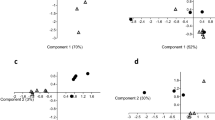Abstract
Single-choice and three-choice tests were used to determine the relative importance of host-plant chemical extracts in eliciting feeding by spruce bud worm larvae. Water-soluble components of the host trees are the most important and, of these, the sugar and glycoside fractions are the most stimulating. The amino acid and organic base fractions have no apparent effect. The organic acid fractions deter feeding slightly.
Similar content being viewed by others
References
Albert, P.J. 1980. Morphology and innervation of mouthpart sensilla in larvae of the spruce budwormChoristoneura fumiferana (Clem.) (Lepidoptera: Tortricidae).Can. J. Zool. 58:842–851.
Barbosa, P., Greenblatt, J., Withers, W., Cranshaw, W., andHarrington, E.A. 1979. Host-plant preferences and their induction in larvae of the gypsy moth,Lymantria dispar.Entomol. Exp. Appl. 26:180–188.
Bean, J.L., andWaters, W.E. 1972. Spruce budworm in eastern United States, p. 378,in W.L. Baker (ed.). Eastern Forest Insects. U.S.D.A. For Serv. Misc. Publ. No. 1175.
Blais, J.R. 1957. Some relationships of the spruce budworm to black spruce.For. Chron. 33:364–372.
Bruning, J.L., andKintz, B.L. 1977. Computational Handbook of Statistics, 2nd ed. Scott, Foresman and Co., Glenview, Illinois.
Davis, G.F.R. 1961. The biting response of larvae of the prairie grain wireworm,Ctenicera destructor (Brown) (Coleoptera: Elateridae) to various extracts of germinating rye seed.Can. J. Zool. 39:299–303.
Dethier, V.G. 1980. Evolution of receptor sensitivity to secondary plant substances with special reference to deterrents.Am. Nat. 115(1):45–66.
Heron, R.J. 1965. The role of chemotactic stimuli in the feeding behaviour of spruce budworm larvae on white spruce.Can. J. Zool. 43:247–269.
Jermy, T., Hanson, F.E., andDethier, V.G. 1968. Induction of specific food preferences in lepidopterous larvae.Entomol. Exp. Appl. 11:211–230.
Kimmins, J.P. 1971. Variations in the foliar amino acid composition of flowering and nonflowering balsam fir (Abies balsamea (L.) Mill.) and white spruce (Picea glauca (Moench) Voss.) in relation to outbreaks of the spruce budworm (Choristoneura fumiferana (Clem.)).Can. J. Zool. 49:1005–1011.
Ma, W.C. 1972. Dynamics of feeding responses inPieris brassicae Linn, as a function of chemosensory input: A behavioral, ultrastructural and electrophysiological study.Meded. Landbouwhogesch. Wageningen 72(11): 1–162.
Mitchell, B.K. 1974. Behavioural and electrophysiological investigations on the responses of larvae of the Colorado potato beetle (Leptinotarsa decemlineata) to amino acids.Entomol. Exp. Appl. 17:255–264.
Morris, R.F. (ed.). 1963. The dynamics of epidemic spruce budworm populations.Mem. Entomol. Soc. Can. No. 31, 332 pp.
McMorran, A. 1965. A synthetic diet for the spruce budwormChoristoneura fumiferana (Clem.) (Lepidoptera: Tortricidae).Can. Entomol. 97:58–62.
Sokal, R.R., andRohlf, F.J. 1969. Biometry. The Principles and Practice of Statistics in Biological Research. W.H. Freeman and Co., San Francisco.
Swaine, J.M., andCraighead, F.C. 1924. Studies on the spruce budworm.Can. Dept. Agr. Tech. Bull. 37.
Wellington, W.G. 1948. The light reactions of the spruce budworm,Choristoneura fumiferana Clemens. (Lepidoptera: Tortricidae).Can. Entomol. 80:56–82.
Wellington, W.G. 1949. The effects of temperature and moisture upon the behaviour of the spruce budworm. I. The relative importance of graded temperatures and rates of evaporation in producing aggregations of larvae.Sci. Agric. 29:201–215.
Wellington, W.G. 1950. Variations in the silk-spinning and locomotor activities of larvae of the spruce budworm,Choristoneura fumiferana (Clemens), at different rates of evaporation.Trans. R. Soc. Can. 44:89–101.
Author information
Authors and Affiliations
Additional information
Lepidoptera: Tortricidae.
Supported by the National Sciences and Engineering Research Council of Canada, Operating Grant No. A9723 to P.J.A.
Rights and permissions
About this article
Cite this article
Albert, P.J., Jerrett, P.A. Feeding preferences of spruce budworm (Choristoneura fumiferana Clem.) larvae to some host-plant chemicals. J Chem Ecol 7, 391–402 (1981). https://doi.org/10.1007/BF00995761
Received:
Revised:
Issue Date:
DOI: https://doi.org/10.1007/BF00995761




